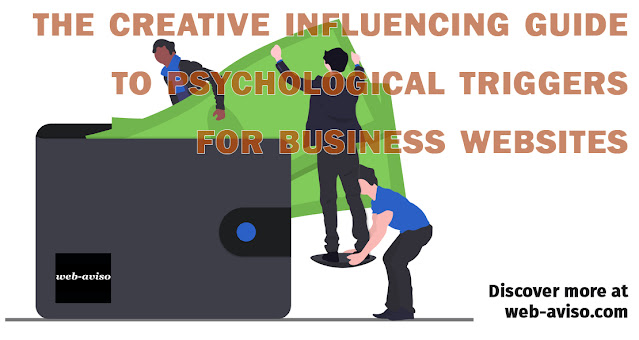The Creative Influencing Guide to Psychological Triggers for Business Websitess
The Creative Influencing Guide
to Psychological Triggers
for Business Websites
With technology developments constantly enabling smarter working and changes of business practices at speed, it might be easy to think that the craft of the marketer has changed beyond recogntion. However whilst the role of the digital marketer requires the ability to keep up with newer specialist skill sets than more traditional media marketing, the core skillset and understanding of psychology remains, it is simply their creative methods of blending newer technology that sets them apart.
Unfortunately with websites becoming so easy to set up and disposable tools for many, it seems that a high percetage of newer creators really have no clue how or where to start with psychology these days let alone using psychology for creative influencing.
So what
you are about to read are the outline of a selection of several practical psychological triggers that can be applied to take basically any idea and
monetise it using laws that 'ethically' exploit human behaviour. Marketers are (or ought to be) keenly aware of the benefits that can come from exploiting cognitive biases as well as the fine line of distinction between marketing and manipulation ...
Hick's Law
For products like coaching or cohort-based programs, one offering will lead to less buying uncertainty and an increase in overall conversions.
Confirmation Bias
Confirmation bias is a tendency to seek out, process, evaluate, or rely on information that reinforces or confirms our own individual experiences or beliefs.Most of the time, we aren’t even consciously aware that confirmation bias has occurred. Advertising campaigns for example may subtly use confirmation bias as a tool to convince consumers they are part of an in-group, often playing off stereotypes and cliches to their advantage, or propping up the customers’ brand identity to a product.
Sometimes, not-so-smart marketers run tests to prove what they believe should work. This is okay. But if they do not continue testing, all they are doing is confirming what they already agree with. What’s the problem with that? Often there are many unseen problems. People want to believe in you, in your product, and in your company. An easy way to do this is to create an experience that fits their perception.This not only builds instant rapport between your potential customer and the offering, but it also frames the problem and solution as something recognisable to them.
Cognitive Load
Customer cognitive load is the amount of thought that’s required to carry out a task.If you’re asked to focus on too many things at once, this makes it difficult for your brain to process the individual pieces of information and this will increase the time needed to fulfil the objective.
For example, a high cognitive load can be caused if you’re trying to read a complex piece of text while having someone talking to you with loud music playing in the background. Everyone handles levels of cognitive load differently, so it's important to reduce the complexity of your product, services, message or website to cater to a wider variety of consumers.
Decoy Effect
The decoy effect is the addition of a third less attractive option placed between two original choices. Decoys are extremely inferior to the first option: (the target), but only partially inferior to the second: (the competitor). The decoy effect asserts that when choosing between two alternatives, the addition of a third, less attractive option can influence our perception of the original two choices or distracts the customer from the lowest revenue per unit item and increases sales per unit with a slightly better option.
Social Proof
Also called informational social influence, its the idea that people copy the actions of others in an attempt to emulate behavior in certain situations. For example, if someone isn’t sure how to act in a social situation they may not have encountered before, they take clues from the people around them. In marketing, social proof covers a similar idea – when people shop, they look for reviews, recommendations and ways that others have used a product before making their decision. This is why online stores work so hard to get people to review their products – it’s a form of social proof that works wonders for increasing the number of people making purchases. Social proof in marketing takes the form of reviews, existing customers, media coverage and more. Let’s learn a little bit more about why social proof is so important and the various types of social proof your business should go after.
Scarcity
Scarcity is the idea that people value things more and are more inclined to act when things are in limited supply. People act when there's a chance they'll miss out - It's in our nature. So scarcity is a strategy that can be used in marketing to make the potential customer perceive that the products is is small quantities or may sell out soon to boost interest and drive sales. It's all about supply and demand. The more rare something is, the more people want it. And that means more sales for you. It works because customers don't know if they'll find something later.
Loss Aversion
This is often used intangent with the scarcity technique in marketing. In simple terms loss aversion is a cognitive bias that states that psychologically losing hurts more than gaining.
Common methods used in marketing and tactics to use loss aversion in your marketing message:
- Discounts – e.g., “save up to X%,” “you’re saving X£'s.”
- Coupons – e.g. “buy 1 get 1”
- Free trials and product samples – e.g., “try now before anyone else does.”
- Pre-ordering options for new products – e.g., “free bonuses.”
- Referral programs – e.g., “Share this link and get X£ coupon.”
- Communicating urgency or scarcity – e.g., “only X days left on this offer,” or“last chance to buy”
- Following up on customers with incomplete shopping carts or orders – “You left a product in your cart,did you forget something?”
Curiosity Gap
“Curiosity killed the cat.” ... It also sold the product. The curiousity gap is the space between the information we’re given and the information
initially withheld, thus exploiting the fact that most people have the desire to find out more or seek the missing information. By highlighting this gap marketers make
potential buyers curious to learn more - so instead of words like: Buy / Learn Subscribe - you can use words such as Reveal / Unlock / Get access. Other techniques include:
- Creating a mystery around a brand, sometimes using visuals
- Leaking interesting teaser information
- Delaying conclusion of an offering
- Pausing campaigns at climatic moments
- Introducing a concept connected with unexpected outcome
- Withholding key information
- Providing drama or excitement with specific campaigns
- Target emotional triggers
Skeuomorphism
Skeuomorphism is a strange world that illustrates a simple idea. It asserts that users will adapt more easily to things that resemble real-world objects. In other words, when you design your products to look like real things, conversions increase. You
probably have seen these hundreds of times, but perhaps you've never
realised that the implementation of it actually serves a very important
purpose. The
first generation of iPhones offered a great example — even users who
had no experience with mobile devices could easily recognize key
functions: The "phone" icon featured a classic handset image, while the
camera button looked like — you guessed it — a camera lens. As digital devices moved into the mainstream, skeuomorphism offered
an easy way for users to connect familiar functions with new UI
elements. Marketing-wise its about humanising something to retain real world association, and not alienate buyers or their decision process.
Anchoring
Anchoring is probably one of the most widely used psychological triggers that most people aren't aware of ... subconsciously the decisions we make are often steered by what are known as anchors. This is a piece of information that we are intentionally or unintentionally exposed to, that becomes a reference point for comparison. Psychologists have found that this seemingly innocuous exposure has a profound impact on the decisions we make. Using anchoring in marketing is about leveraging the fact that we use benchmarks to evaluate options, no matter how arbitrary the anchors may be.
For example in 2010, when Steve Jobs was unveiling the first version of the Apple iPad, he held a tech conference for the pitch. During the price reveal, the backdrop behind Jobs showcased a number, $999. Now, it's important to remember in 2010 that this type of technology was new. Jobs preceded to share his pitch about this new invention. The features, the benefits, and everything in between. Finally, however when it came to the price reveal, Jobs' backdrop changed… it read $499. He had anchored a price of $999 onto his audience and then dropped that price in half. This created a deal in the minds of the viewers and resulted in record sales for the company and this new product. Here are a few other examples :
- Find your ‘5 a day’ – a diamond company told us an engagement ring should cost three months wages, a bed company tells us our mattresses need to be replaced avery eight years. What numbers can you anchor in your customers’ minds to increase the price they pay.
- Drop big numbers that set customer expectations – Three’s Brexit bus tour stated that its customers would save £187m in roaming charges when the UK leaves the EU. Try to shake that figure from people’s minds if you’re Vodafone et al.
- Make the important numbers memorable – Simba’s ‘100 days’ is a big round number, once you’ve seen it you can’t forgot it when comparing other mattress brands.
- Always go big to small – one of the best lines a salesmen can hit you with is ‘normally we would charge £345 for this additional service but as you’re a regular customer we can do it for £225’. Before you’ve even had a chance to think you already feel like you are getting a good deal, even though that £345 might be an arbitrary number.
Pseudo-Set Framing
Pseudo-Set Framing can be utilised by businesses to encourage consumers to purchase or donate more than they originally would have. Research has shown that pseudo-set framing— arbitrarily grouping items together to create a ‘set’— can affect gambling choices, effort, giving behaviour and purchase decision making.
Summary (TL;DR)
Psychology unlocks opportunity !
If you want want to know how advanced strategies like this can build traffic to your website - Contact web-aviso today and we can help you with strategic content tools and ideas can use and go beyond what we've written about above.
web-aviso have been have been providing digital marketing, SEO, publishing and print design services to businesses across the UK and internationally since 2004 ...





Comments
Post a Comment